Round Britain with Moonshine
Read John Hooper’s account of his voyage in his Maxi 1100, summer 2006
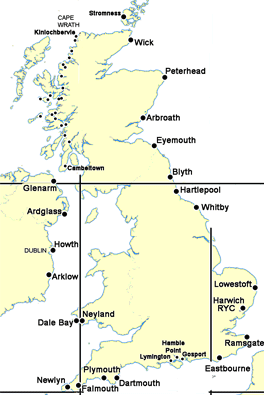 Five years ago I was fortunate to be invited to crew on a friend’s yacht from Peterhead to Oban through the Caledonian Canal. This was a memorable and enjoyable experience which gave me my first taste of sailing in Scotland and which I was determined to build on.
Five years ago I was fortunate to be invited to crew on a friend’s yacht from Peterhead to Oban through the Caledonian Canal. This was a memorable and enjoyable experience which gave me my first taste of sailing in Scotland and which I was determined to build on.
Having done the Canal, as crew, I was keen to see if I could go right round the top, as skipper, and started to make my plans with that in mind. The pilot books do their best to make the Pentland Firth and Cape Wrath seem as frightening as possible but it became clear that the Summer months provide reasonable periods of calm enough weather if one is lucky. The key lies in getting the tides right and, for the Pentland Firth in particular, it’s best by far to tackle it at neaps, as Spring tides can run in excess of 8 knots. Provided there’s an absence of fog and winds are less than F4 there shouldn’t be too much of a problem…We set off from Harwich on June 5th, which allowed us 12 days to get to Wick, the jumping-off point for the Firth, neap tides starting on 17th. If the weather turned foul before we got there, we’d go through the Canal, making our decision at Peterhead. In the event, when we got to Peterhead, conditions looked pretty stable and we had a good passage across the Moray Firth, arriving at Wick in late afternoon on the 14th. In fact, winds were so light that we had to motor most of the way.
Our first stop had been Lowestoft which hadn’t proved to be as easy a first passage as I’d planned as the wind was mostly 3 to 4 and on the nose. It took us 11 hours of motor-sailing, about 3 hours longer than anticipated! My crew was Ian Miles, my brother-in-law, and Sam Block. Nevertheless we got a good meal at the Royal Norfolk and Suffolk that evening, and knew we were on our way.
The passage to Whitby was going to be our longest of the whole trip, but the forecast looked OK and we cast off just before 08.00, to catch the N. going tide. By noon the skies had cleared and it was hot, but there wasn’t much wind, and it wasn’t till early evening that we were able to hoist the main and start sailing. The night was spent dodging gas-platforms and varying between motoring and sailing, but by 05.30 we had Flamborough Head abeam, and by 10.30 we were off Whitby. It was a glorious morning. After a little bit of standing off, the bridge opened at 11.41 (Reed’s doesn’t lie) and we entered the marina.
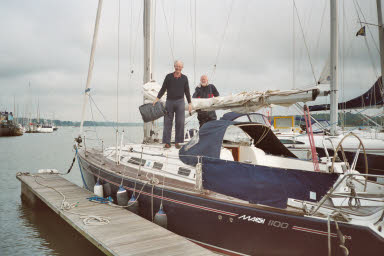 After catching up on some sleep we had a little time to explore. I climbed the 199 steps to the church and abbey and admired the view.
After catching up on some sleep we had a little time to explore. I climbed the 199 steps to the church and abbey and admired the view.
Tony Pollard, Sam’s replacement, and a keen non-sailor, arrived at 6, so all of us plus Tony’s wife Sandra had a pleasant drink on board followed by a good meal ashore. We’re woken at 5.30 the next morning by the new boy,who thinks it’s 7 o’clock. Oh dear!. We bundle Sam off to the station for his journey home, and exit the marina at 12.31, to find a sea fret and about 1/2 mile of visibility, but a bit of breeze from ESE.
An hour or two later we can see Staithes and Runswick Bay. We’re sailing under main alone, and it’s turning out fine. Arriving at Hartlepool at 6 o’clock, we scrape over the cill and enter the lock with 2 other yachts. We get a very friendly welcome, and apologies from the HM for not being on the pontoon to take our lines. A fine dinner on board: crab salad followed by Cod Basquaise, courtesy of the aspiring newcomer.
Re-fuelling is very easy here, and we take advantage then, after locking out we enjoy some beautiful sailing before the wind dies away and it’s on with the engine. We pass Sunderland and Tynemouth and then enter the river at Blyth and find a visitor’s berth at the Royal Northumberland Yacht Club. Our visit has coincided with the Club’s annual overnight race to the Farne Islands and back, so there’s a frenzy in the Clubhouse and we miss out on the promised pie and peas, settling for second-best burger and chips. We watch the departing boats and wish them luck. There’s no wind to speak of, though by the time we leave at 6.0 the next morning it’s blowing a nice F3 from the ESE, and filling. By the time we get to Coquet we are stonking along, and by noon we’re able to round up and drop anchor in “the Kettle”, a favoured spot in the Farne Islands. This is absolutely delightful. One or two tripper boats, but otherwise a glorious spot for an alfresco lunch. From there, the wind starts to build a little but we have a fine reach past Holy Island and, later, Berwick and our entrance into Eyemouth Harbour is quite exciting involving a handbrake turn in quite a small space and, now, with the sea fret closing in again.
We have to raft up here, one out, but it’s comfortable enough, and we’re able to slip our lines at 7 o’clock and head North, straight across the Firth of Forth. It’s hazy, so we don’t see Fife Ness, but there’s no wind. By the time we arrive off Arbroath it’s a fantastic, hot, and sunny day. The old inner harbour has been fitted out with floating pontoons and it’s a very pleasant place to stop. Entry is via a lock , which is not manned at night, so some thought has to go into arrival and departure times.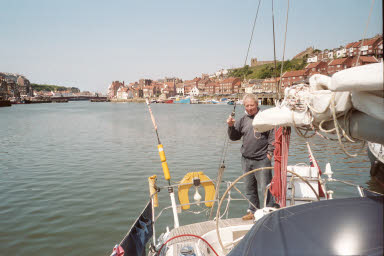
As we seem to have some time in hand, and the weather seems fairly settled, we’re able to enjoy a very diverting day in the company of old friend Duncan Gray who farms about 6 miles up the coast. He collects us about 11 o’clock and gives us a very interesting tour of his estate, ending up at the big house for a wonderful lunch prepared by Claire. Then back to the harbour where we put our new plan into action. The last lock opening time is 6pm so, as everything appears to be in order,and the weather’s fine, we decide to leave then and night-sail the 64 miles to Peterhead. The wind is in the SSW, perfect, and we set the jib alone,which gives us 5 knots+. The evening is fine and we have an uneventful night, arriving at 8 o’clock to a beautiful sunny morning. The marina is on the South side of the harbour, and is an excellent stop-over, with the shower block and facilities rated at 10 out of 10.
After a short kip and a fry-up, Ian and I caught a South going bus to Cruden Bay where we had a good walk along the cliffs to the ruined Stains Castle, set right on the cliffside, with an uninterrupted view towards Norway. Annoyingly, I didn’t find out till later that we were within yards of Butcher’s Hole, an intriguing rock hole which Johnson and Boswell had visited 200 years previously. Nevertheless, the inlets and fissures we saw in the rocks were certainly dramatic.
This is decision time. The Canal or round the top? All available info points to settled weather, so I decide to go for it. At 4am it’s a grey, mizzly day, and there’s a light wind on the nose, but we set the main in the harbour and head North. By mid-day it’s getting hot – the clouds have disappeared, but we’re motoring. All change at 2 o’clock: the wind veers SE and freshens and we have a lovely sail for 3 hours, arriving at Wick, and tying up in the inner harbour before 6. A little bit of berth-juggling with a couple of Norwegian yachts, and we’re settled against the harbour wall, just in time for our scout to reserve a table at a nice little French restaurant “Au Bord de l’Eau” about 10 minutes walk from the quay. This definitely isn’t the Scotland I’d remembered!
It was the 14th June, and we’d taken 9 days to cover the 500 miles from Harwich.
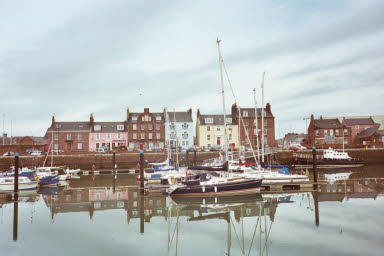 We said good-bye to Tony the following morning and anxiously waited for news of Johnathan, who’d gone incommunicado – only taking relayed text messages via his girl-friend in Wales. I’d originally asked J. to be in Wick by 18th, yet it looked as though 16th and 17th would remain calm but winds due to freshen on the 18th. Ian and I took the bus to John O’Groats to reconnoitre. This proved to be very interesting and somewhat reassuring. We could quite easily see across the Firth and identify where we were due to go by boat, these Southern Orkney Isles being only about 5 miles away at most
We said good-bye to Tony the following morning and anxiously waited for news of Johnathan, who’d gone incommunicado – only taking relayed text messages via his girl-friend in Wales. I’d originally asked J. to be in Wick by 18th, yet it looked as though 16th and 17th would remain calm but winds due to freshen on the 18th. Ian and I took the bus to John O’Groats to reconnoitre. This proved to be very interesting and somewhat reassuring. We could quite easily see across the Firth and identify where we were due to go by boat, these Southern Orkney Isles being only about 5 miles away at most
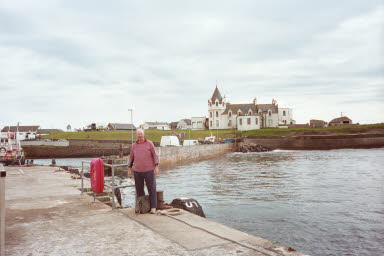
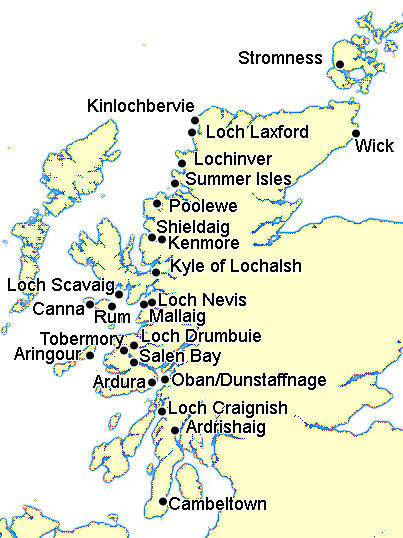
That night in Wick was spent with Ian silently practising the lambasting he was going to give J. for being so inflexible and for putting the entire trip at risk. I was feeling guilty for not having explained the situation thoroughly. Awakened on the 16th at about 6 o’clock by a cry from the dockside – “Ahoy Moonshine” and J. had arrived – having put in a 4 hour night drive from Edinburgh. The relay had worked!
Much relieved, we set off after lunch, working the tide so as to be off Duncansby Head at slack water, deciding later that we were probably still an hour too early. Apart from the tide, conditions weren’t exactly ideal. A very light wind on our starboard quarter meant we had to motor and visibility was varying from 1/2 mile to begin with to 1 mile off Duncansby Head. I don’t mind sailing in fog if I have to, as Moonshine has a good radar system, but it did mean we didn’t have any view to enjoy which was a pity. By the time we got to Scapa Flow, though, we had 3 miles vis., which was good.
The stratagem of going to Stromness, rather than hugging the coast to Thurso and Scrabster, seemed eminently sensible as it avoids the “Merry Men of Mey” – the worst of a series of overfalls between Sutherland and Orkney. Added to which, the Orkneys are an attractive destination themselves and, had our schedule allowed, it would have been nice to linger and explore. In the event, we spent two days ashore; hiring a car on the second and seeing as much of Mainland as we could. There is a lot to see and we found it fascinating: the terrain more like Western England than Northern Scotland: extraordinary historic and prehistoric sites.
Exit from Stromness was, again, very tide dependant. Up to 8kn can be found in the Sound of Hoy, though less at neaps, so we timed our departure accordingly and recorded about 5kn, in our favour, for about an hour and a half. Wind direction was favourable, and we were zooming along under reefed jib alone. Once more, tidal calculations played a big part – we wanted to arrive at
Cape Wrath, about 60 miles away, at slack water, so we didn’t want to go too fast. The day was overcast and there was a big swell, but visibility was fair. If the weather deteriorated we were prepared to go into Loch Eriboll ( ‘orrible, as the locals called it), but with the wind abating from Force 5 toForce 4 as we approached the Cape, and staying Northerly, we decided to press on to
Kinlochbervie, about 15 miles further on. The sun came out as we arrived, and we were delighted to find a pontoon where we could raft up against one other boat.
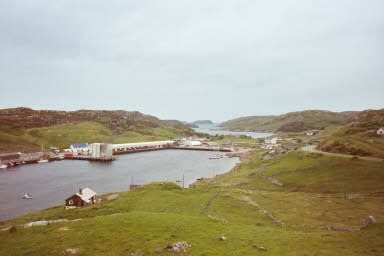
This berth turned out to be quite fortuitous: yachts are usually required to moor alongside the harbour wall on the side by the fish dock, with all the hassle that that entails. Our neighbour, Patrick Boddy, was also passage making, but larger than us, and with no immediate plans to leave, was an ideal craft to be alongside. The following day the weather turned. We’d been lucky to get in and we couldn’t have found a more secure harbour. Added to which, there was every amenity on hand and lots of shore-side interest, starting with the Royal Mission for Deep Sea Fishermen , opened in 1986 by the Duchess of Westminster, where we were able to get excellent showers and, later, a superb fish and chip supper followed by spotted dick.
For anyone interested in World Cup football (not us) the Kinlochbervie Hotel had a wide-screen TV and a bar open all day, serving excellent Bellhaven beer. What’s happened to Scotland? This turned out be the norm, now; no more closing at 2 o’clock and we even found restaurants serving food till 10 at night. Incredible.
The fish market in Kinlochbervie was very interesting. We were lucky enough to watch an auction one afternoon, with all sorts of strange looking fish being sold, alongside various others we recognised. The big disappointment was not being able to obtain any langoustine. The one boat that came in with a catch wouldn’t part with any as they’d already been sprayed with some preservative. We never found out what that was, but we did get a 4lb halibut by way of compensation, which was delicious.
Eventually the weather eased in Kinlochbervie and we were able to set off for Loch Laxford, 10 miles down the coast. This is the setting for John Ridgway’s adventure training school and is set in spectacular scenery. Two other yachts were at anchor, one of which turned out to be “English Rose iv” – the Westerly that Ridgway sailed to Brazil in the first single handed race round the World, that was eventually won by Sir Robin Knox Johnston in “Suhaili”. Not long after we’d anchored a dory approached and we were very affably greeted by JR himself. Again, the following morning, he came and had a longer chat, talking about the numbers of people who’d been through the school and how they’d fared. An interesting interlude before setting off for Lochinver, a 35m passage South.
Billed as yet another busy fishing harbour with no facilities for yachts, we were lucky to find a pontoon with a spare finger which, according to the maintenance man working on it hadn’t existed the day before! It seems that most of these Scottish harbours are realising that it’s worthwhile to start accommodating pleasure yachts as the fishing fleets decline.
We had a difficult decision to make. Did we eat in the up-market-looking restaurant or the busy pub next door? The restaurant got the nod, and we had yet another excellent Scottish meal. The following morning we discovered an excellent butchers, next to the Spar, and top of the range toilet facilities at the massive, newly opened sports centre.
The next few days contained some of the most delightful of the trip. We felt relaxed after our successful negotiation of the Northern Capes and we had time in hand before our next rendezvous and crew-change at Kyle of Lochalsh. The morning started mizzly, but after a leisurely morning the day gradually brightened and we had an enjoyable sail to Tanera Beg, in the Summer Isles where we found a lovely anchorage by ourselves. Caught our first mackerel here and watched a gorgeous sunset. It was Midsummer’s Eve.
Surrounded by seals, and lots of terns, we set sail for Loch Ewe – stopping for lunch., of grilled mackerel, at a delightful island of Cara Lar, on the way. The following morning we dinghied ashore at Poolewe, the head of the Loch, and visited the extraordinary gardens of Inverewe. Designed and created by Osgood MacKenzie in the period from 1862 when he inherited the estate till his death in 1922, they took advantage of the benign climate created by the proximity of the Gulf Stream and were full of specimen plants gathered by MacKenzie in his travels all over the World. I can’t do justice to describing them in detail but, suffice to say, they were well worth the visit.
On our return to the dinghy, now stranded at the top of the beach, we found it surrounded by a surfeit of mussels of a generous size which we happily gathered for an excellent meal the following day.
With a light wind against us we motored North out of the Loch, past various warships, and into the Minch, where we turned, first, West, and then South past Rubha Reidh. Here followed a glorious goosewing run, with the sun shining, down to Loch Torridon where we anchored in 8m. at Kenmore – the only vessel in sight. Only a few houses here, plus the ubiquitous red phone-box, so didn’t venture ashore as we were self-sufficient that night.
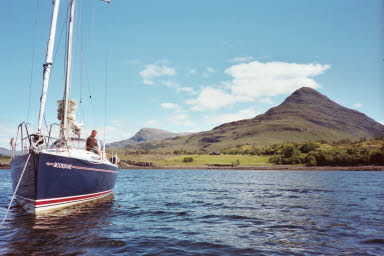
A lazy day followed as we pottered down towards the head of the Loch and dropped anchor for lunch under Ben Dampf, enjoying one of the most spectacular views in the Highlands. After a snooze, we motored round to a delightful anchorage opposite the very pretty village of Shieldaig, in the shelter of an island preserved as a heronry, and dinghy ashore in an attempt to catch the shop. Unfortunately too late, but find an excellent outside bar attached to the hotel and have a pretty good meal there, having declined the £41.00 set dinner at the Hotel itself.
In the morning, Johnny and Ian head for the shore with the gash and shopping-list and J. finds hot water & WC in public conveniences next to the refuse bins. A good breeze is blowing and we have a fabulous sail on a broad reach through Loch Torridon. Reefs in and out over the next few hours as we tack towards Rona and back. To the East is the desolate Applecross Forest and to the West the Isles of Rona and Raasay. The wind reaches F6 at one point but then settles around F4. One or two fishing vessels to dodge, but no sign of any submarines. (It’s a designated exercise area).
At last we catch a glimpse of the Skye Bridge and after leaving the Crowlin Islands to starboard we shoot the bridge at 7.00pm. Glorious views of Skye and the Cuillin Hills.
We’re not quite sure what to expect at Kyle of Lochalsh, but we find a single pontoon, parallel to the shore, with 4 or 5 yachts already there and we raft up outside one. Very handy for the town, but I resolve to try and get to the inside as I have 2 days before my next crew arrive.
Johnny and Ian have arranged their departures for the following morning. J. takes the 0725 train to Inverness, as he has to retrieve his car from Wick and Ian follows on by bus at 1020 for his connexion to London, having kindly stayed to help me move the boat round to a berth which has become vacant on the inside. This pontoon has water but no electricity. Everything in the town is within very easy reach: the bus stop is at the end of the pier and the station and harbour-master’s office 1/4 mile away. There’s a manned public loo near the Tourist Information office and the attendant takes care of laundry and issues tokens for the shower.
I enjoy my stay here, doing chores and having a haircut in between taking the bus to Eilean Donan Castle and walking to Kyleakin over the bridge. Don’t much like the look of Kyleakin, though it’s obviously much more sheltered if there are strong winds from the North and West. Later on, J. arrives – complete with car – and we set off to see Plockton. A lovely looking harbour, we enjoy a drink at the Plockton Hotel but decide to eat at a little bistro called “On the Rails”, which is actually the waiting room for the railway station. Excellent.
Having the car is a real treat. J decides he has enough time in the morning to show me Skye, so we spend 3 hours motoring around the Island, calling in at Portree on our circuit, and seeing parts that I am not going to have time to visit. He bids farewell at noon and I wait for Gerry who’s due to arrive from Glasgow in the afternoon. He should have had Richard with him, and Liz too, but a serious bug has kept Richard at home unfortunately, and Liz can’t get away from work.
I treat Gerry to a nice piece of haddock, all the local shops being plentifully supplied, and we make plans for the morning. We have a week to get to Oban.
Sunday dawns dull and we don’t get away till noon, timing our departure for the tide in Kyle Rhea, the narrow channel at the top of the Sound of Sleat. There’s not much breeze. Decide to explore Loch Hourn (Loch Hell) and the breeze picks up nicely. Really dramatic scenery here, with the deserted Knoydart peninsula to the South. About turn, as the sun comes out, and we head for Loch Nevis (Loch Heaven), dropping anchor off Glaschoiffe House. A short dinghy ride ashore, then a 40 minute walk to the Old Forge at Inverie, the remotest pub in Britain. We had an excellent meal here and a couple of good pints, too. It’s a lovely spot, and only accessible on foot or by water.
We enjoyed an incredibly quiet night and, the following morning, motored across to Mallaig, a busy ferry harbour, where we filled up with fuel, benefitting from some extremely friendly assistance from the attendants. By this time, the wind had piped up from the NE and a stiff chop was blowing into the harbour, so we put 2 reefs in the main and hoisted sail in the harbour. We set a course for Rum.
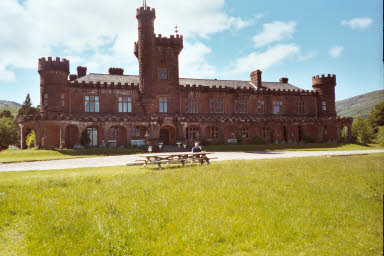
Three hours later we arrived in Loch Scresort, the main approach for
Rum, and dropped anchor in 4.5m, with a fine view of the main attraction: Kinloch Castle, a late Victorian pile built by Sir George Bullough. We dinghied ashore but found we were half an hour late for the daily guided tour, which was a pity. However, by walking round the outside, we were able to see the main features, which were the original furniture and furnishings dating from the late 1890’s when the castle was built.
Rum is also sanctuary to about 30,000 red deer, but in our brief time there we didn’t observe any. It’s a lovely island and there are one or two places to stay if one wanted to.
Back to the boat, and set sail for Canna under blue skies, with the rare Manx Shearwaters circling above. We have fantastic views of the Cuillin hills on Skye. To our surprise, there are 10 or 12 boats already at anchor when we arrive and the choice of place to drop our hook is quite restricted. At out first attempt, we receive cries of discouragement from nearby boats, with the word “kelp” being the most prominent. This results in us circling for several minutes before selecting a spot where we can’t hear the cries! As soon as we are settled, we receive a radio call from a vessel anchored close by which turns out to be “Rona” , a Maxi 1100 like ours, skippered by Laurie & Jennie Prescott. We dinghy over after supper, at their invitation, and enjoy a dram and a chat and, in the morning, we fetch them over to “Moonshine” to return the compliment.
By the time we’ve dinghied ashore and enjoyed a walk along the foreshore most of the other boats have departed. We don’t have much trouble retrieving our anchor, though there is some kelp, and we’re glad we set the tripping line, as advised.
About mid-day we hoist the main and set sail, via Loch Brittle, for Loch Scavaig, billed as one of the World’s finest anchorages. We are not disappointed. We have one other yacht for company, otherwise an uninterrupted and breathtaking view of the Cuillin Hills from an enclosed pool about 1/4 mile in diameter and we are in about 4 metres. The morning had been lovely, but now we were getting a shower so prepared supper whilst it passed over and then dinghied ashore for a walk up to and along the beautiful fresh water Loch Coriusk. Very peaceful, with lots of bird life, mostly terns.
After a very quiet night we awake to some sunshine and the magnificent Cuillins. Breakfast of porridge, on deck, and then up anchor and pick our way gingerly through the rocks guarding the entrance. Many seals lazing about and the water completely flat calm as we motor South. We see lots of puffins and shearwaters. For company, we see the occasional fishing vessel and one or two yachts and we have fine views of Rum and Eigg and Muck.
Arriving at Coll late afternoon we pick up a mooring in Aringour, the main harbour on Coll. Here, we are able to pick up some stores and as the Coll Hotel looks attractive we book a table for 8.30. How Scotland has changed! Only a few years ago it was impossible to get a meal after 7 o’clock: this time we found all sorts of good restaurants in unlikely places and all serving till late in the evening.
After a short walk up to the church, which had a lovely wooden arched ceiling and, unusually,windows with a view over the harbour, we repaired to the hotel for excellent Cullen Skink and Scallops. Excellent!
Just as the pilot book said, with wind in the South, there was a swell on the mooring and from 4 o’clock onwards it got quite uncomfortable with a force 4 to 5 starting to blow. We set two reefs in the main before leaving the mooring and headed off through fog for Mull. Visibility was less than half a mile now, but we were flying along nicely. Radar is a great confidence booster. 4 hours later we were off Tobermory, and ventured into the harbour where we picked up an available mooring and had lunch.
It was this passage, in reverse, that nearly saw an end to Dr Johnson and Thomas Boswell as they were nearly dashed on the rocks of Coll during their tour of the Hebrides, in 1773. The storm they encountered left quite an impression on Boswell.
As the weather was becoming unsettled and we had a crew change planned for the following day, at Oban, I thought we should get a bit closer so cast off and motored down the Sound to Salen Bay where we dropped anchor for the night. We couldn’t find the visitor’s moorings that the pilot book said existed. A longish walk through a council estate to find a Spar, but there was a pub where we enjoyed a couple of pints.
Woke to a fairish day, with a decent breeze and, after a good fry-up, set sail for Dunstaffnage – our marina-of-choice (as recommended by Chris Brown) and duly arrived about mid-day. Stunning views along that part of the Sound.
As we ascended the steps to the HM’s office, there getting out of a taxi was Liz, having just arrived from London overnight. Great joy! Just 2 hours later our friends Peter and Anne Goldsworthy arrived and we idled the afternoon away on the terrace of the “Wide Mouthed Frog”.
We’d had pretty miserable weather for the time that Peter and Anne were with us in the Baltic and, sure enough, it started to turn for the worse now as we headed back up the Sound to Tobermory. This time we laid an anchor, after several passes as the mooring were all taken and there were quite a lot of yachts, but the sun appeared for us in the evening. We had some anxious moments during the night as the wind veered and we were quite close to a shore which shoals rapidly. In the morning, we notice a vacant visitor’s mooring close by and gratefully take it up. The weather is horrible by now, and it doesn’t look as though we’re going anywhere, especially as we find the top slider on the mainsail luff has broken.
Sure enough, the town is very attractive and there’s enough to see and do to keep us amused for a while. There’s a smallish chandlery on the seafront and it does have the replacement slider we need, which is thoroughly good news, and we’re able to make the necessary repair.
With no break in the weather, we decided to hire a car and explore Mull by road. This was a delightful experience, with stunning views of mountains, waterfalls, lots of sheep and a few mountain cattle. We got as far as Fionport and looked across the sound towards Iona, linked by ferry from where we were. Not much in the way of hostelries, we ended up back in Salen, for an evening meal, where we had seen a promising looking Italian restaurant. Sadly it didn’t live up to expectations, and we wished we’d pushed on to Tobermory.
It’s Wednesday, and we’re longing to get moving, but still the weather is dull. We fill up with diesel and water, very handy on the newish pontoon, and head out of the bay. To the North East is Loch Sunart, full of twists and turns and we have a good sail half way down, then turn back and negotiate the narrow entrance into Loch Drumbuie – a very pretty Loch, surrounded by hills and well sheltered. We share the anchorage with about a dozen other yachts and enjoy a peaceful night’s sleep.
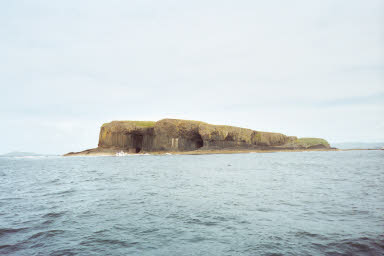
Still cloudy, the following morning, we weigh anchor (from 14 metres) and head West towards Ardmore Point under motor as the wind’s on the nose. By 10 o’clock we can alter course to the South and hoist the sails with a steady breeze from the North West. Past the Treshnish Isles and on to Staffa where we get a great view of the caves from about ¼ mile off. There’s just too much swell to think about putting a party ashore in the dinghy, and not quite enough enthusiasm.
By 3 o’clock we’re in the Sound of Iona and drop anchor in 4m at Port na Fraing, where we dinghy ashore and embark on quite a long walk to the Abbey and the village where we look across to where we’d been in the car two days earlier. It’s all very ordered, but there are quite a lot of tourists and Iona doesn’t quite manage to live up to it’s billing, though maybe we should have stayed longer and walked to the Western shore to get a fuller flavour. The rock colours are striking, though, being a sort of lobster pink granite – quite different from anything else we’ve seen before.
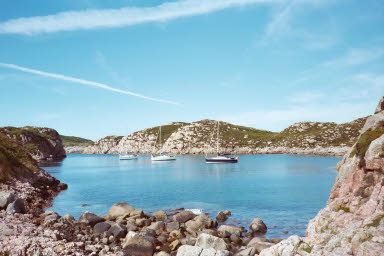
Back to the boat and head the 2 miles South to find the entrance to the famous Tinker’s Hole – a renowned favourite amongst yachtsmen in these parts. Sure enough, it’s delightful: a pool enclosed by rocks with not a glimpse of habitation in sight and we anchor in 4m in company of 3 other yachts. The sun comes out and we dine on deck.
We wake to a lovely morning and spend a leisurely morning nature watching before heading out into the Firth of Lorne and turning East. Motoring now, as there’s no wind, we enjoy our passage along the South of Mull and turn into Loch Spelve just after five, dropping anchor in 10m at Ardura in the NW corner of the Loch. We have the Loch to ourselves and a pleasant, fine evening. Peter and I row ashore, but can’t find a path, so then row out to a mussel farm where we are surprised to find all the strings empty.
A delightfully quiet night, followed by breakfast on deck and with wind from the West we have a wonderful sail back to Dunstaffnage, through Oban Bay and then into the Lynn of Lorn. It’s a glorious afternoon as we moor stern-to in the marina, with an easy stroll to the Wide Mouthed Frog for dinner on the terrace.
We all go to Oban the following morning, just 3 miles down the road, by taxi, for Anne & Peter to catch their train to Glasgow. Liz and I do a big shop at the town’s huge Tesco, then head back to prepare for our next crew who are due that evening.
Harriet & Donald Brown duly arrived, cheerful but exasperated. Victims, yet again, of Ryanair’s policy of labelling its destination some 30 miles from the place-name. In this case: for Glasgow read Prestwick. Bungled train connexions etc meant a long wait at Glasgow station. Not a lot of sympathy from me or Liz.
My plans for the following day included the possibly tricky passage through the Sound of Luing and then the Dorus Mor, where currents and eddies could be problematic. We were also due to pass within a few hundred yards of the notorious Gulf of Corryvreckan, which the pilot book describes as one of the most dangerous stretches of water in the British Isles. Fierce whirlpools and standing waves can occur when strong winds oppose strong tides. Small boats are regularly smashed to smithereens or lost without trace, etc.
In the event, the wind, which had started strongly, died away by the time we left Kerrera Sound and we ended up motoring. I was glad we’d planned our passage time carefully, though, as we were getting 3½, sometimes 4, knots of tide through the Sound of Luing, with first Scarba and then Jura to starboard, and it was fascinating observing the eddies and mini-overfalls and feeling the pull on the rudder.
Through the Dorus Mor in similar fashion, we were soon at Crinan, where we picked up a waiting buoy and had lunch before heading back North a mile or two into the peaceful waters of Loch Craignish where we anchored for the night,off Goat Island.
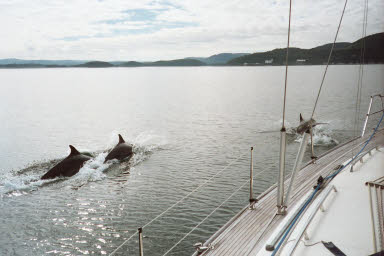
Heading back to
Crinan next morning, I caught sight of the Ajax – this time at anchor (ref. log of Lady Jan Claire, when she was spotted under sail), before we were overwhelmed by the most amazing school of dolphins. For an ½ hour or so they frolicked and gambolled around the boat, perhaps 20 in number and leaping and diving all around us. It was unforgettable.
At 10.30 we entered the sea-loch, at the entrance to the canal, and found we were the only boat going South – possibly a mixed blessing. The canal is 9 miles long and is a short-cut across the Mull of Kintyre. There are 15 gates, of which 11 are self-operated, which was quite hard work, but the scenery is stunning and the day got sunnier and sunnier and we enjoyed ourselves – particularly when we got to the Hotel ½ way through.
At last we found ourselves at Ardrishaig, and neatly tucked up in the basin, proud of our feat of having done the canal in a day. A pleasant spot and adequate showers next to the Harbourmaster’s office. Up with the bimini and enjoy our dinner on deck.
Tuesday dawns fine and we leave the basin via the sea-lock about 9.30, with a decent F4 but from the South, so we start by tacking down Loch Fyne, with the Isle of Arran a distant hump on the horizon. Around lunchtime the wind dies away and we motor for a while and then the wind picks up,this time from the NE and we are able to sail gull-winged for nearly an hour, or with donkey’s ears as the Latin Americans call it. Again, it dies and we motor till half past six when we enter Campbeltown harbour and raft up alongside “Bojangles”. It’s a gorgeous evening: up with the bimini and drinks on deck before venturing into town where we find the bistro closed and a stuffy looking hotel. We settle for fish & chips from Rab’s Fish Bar (famous for 50 years).
 We awake in Cambeltown to rain and overcast skies and not much breeze. What there is is from the NE so we’re able to motor sail till we get abeam the Sanda Isles where the wind freshens nicely and we’re able to beam reach for 2 or 3 hours before it dies completely as we approach Glenarm. Here we find plenty of room, in the cosy harbour, and tie up alongside in a visitor’s berth. After deflating and stowing the dinghy, which we’d towed for 500 miles, we walked into town for supplies. As the evening drew in, a thick fog descended, and we watched in amazement as the local rowing fours practised up and down the harbour, looming out of the gloom with the cox yelling instructions. All modern facilities here, with good showers and free internet access in the HM’s office.
We awake in Cambeltown to rain and overcast skies and not much breeze. What there is is from the NE so we’re able to motor sail till we get abeam the Sanda Isles where the wind freshens nicely and we’re able to beam reach for 2 or 3 hours before it dies completely as we approach Glenarm. Here we find plenty of room, in the cosy harbour, and tie up alongside in a visitor’s berth. After deflating and stowing the dinghy, which we’d towed for 500 miles, we walked into town for supplies. As the evening drew in, a thick fog descended, and we watched in amazement as the local rowing fours practised up and down the harbour, looming out of the gloom with the cox yelling instructions. All modern facilities here, with good showers and free internet access in the HM’s office.
With the next crew change planned for Dublin in 2 days time, we had to press on. Visibility the next morning was not good, never more than a mile all day, but the passage to Ardglass looked straightforward and with no wind, we motored the 60 miles in exactly 10 hours. Quite a lot of traffic coming in and out of Belfast and the radar was in constant use.
The sun came out as we docked in the pleasant little harbour and almost instantly were presented with a gift of 5 mackerel and some crab claws by an adjacent fisherman.We were able to fill up with diesel in 2 x 25 litre cans from a nearby garage and, again, there was a good, modern, shower block.
Our next target was
Howth, 60 miles away, with not much sanctuary between. Irritatingly the promised Easterly started as a South Easterly and veered again after an hour, remaining 30 degrees off the bow all day, which meant we couldn’t hold our
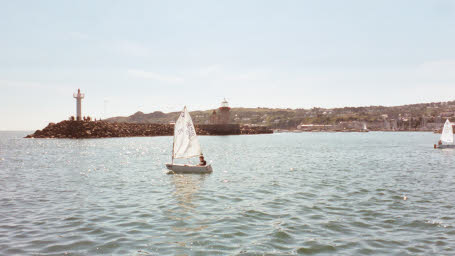
course. At the same time, the sea state was lumpier than we’d been used to, so it was quite tough going beating into F4 and later F5. By 4 o’clock we still had over 20miles to go and conditions were worsening so we put the engine on and motor-sailed. At 5 o’clock we put a second reef in the jib and main and battled on. It was 8.15 when we tied up in Howth, only to be told we would have to move so Liz was despatched to warn the cook, while the rest of us tidied up. Scruffy, but elated, and swaying like mad, we found the warmest possible welcome in what turned out to be a very smart dining room. It was Saturday night and Donald’s birthday so we celebrated in style. The surroundings and cuisine were 5 star and, to cap it all, the Chief Steward, on hearing that I was on a circumnavigation, presented me with a very fine volume telling the history of Howth Yacht Club.
Awoke on Sunday morning to a lovely day and delightful surroundings. We enjoy a leisurely breakfast on deck, having showered etc in the most sumptuous club-house imagineable and then load Donald & Harriet into a waiting taxi for their short ride to Dublin airport.
Our stay at Howth is extremely pleasant. The club iself is extremely well appointed and is ideally located on the attractive promenade. The village is a short walk away and we are able to find an amenable wine merchant who agrees to deliver our order to the boat: our original stocks by now being seriously depleted. There is a festive air on the Sunday as an open air market is set up on the prom and the quayside iteslf contains some wonderful fishmongers , grocery stores and restaurants.
On Monday we walk to the local station and take a 30 minute train ride into Dublin City. After a stroll through St.Stephen’s Green we take a tour of Trinity College, which includes a visit to the Book of Kells, beautifully displayed along with several other illuminated manuscripts. Then back to the boat in time to greet our next crew, Douglas Pike, who is due to fly in from Stansted.
On the Tuesday we set off South for Arklow, having filled up with diesel at the Club, but, again, we’re bedevilled by a lack of breeze. Every now and then the wind picks up and we’re able to enjoy some glorious sailing, and benefitting from 3-4 knots of tide round Wicklow Head. By half past five we enter the river mouth and decide to head for the new marina on the North Bank. This proves to be pretty small, but we manage to squeeze in somehow, and discover yet another well-appointed shower block next to the Marina Office. From the marina to town was quite a long walk but took us past the local sailing club where, from several members we chatted to, we learned that Wexford, my next planned stop, was actually a no-no. The entrance channel was just too tortuous and badly defined, and none of the locals used it.
This left us in a bit of a quandary. The safe harbours past Wexford were actually not much closer to Milford Haven, our destination, than we currently were, and the winds were likely to be against us in any case. It was disappointing that Douglas wouldn’t get more sailing and that we wouldn’t see a bit more of Ireland but the best plan seemed to be to leave our berth whilst it was still light and make a passage overnight that would allow us to make landfall at daybreak. This was duly agreed, and we set off in late afternoon, into a lumpy sea and with a bit more wind than expected. As we progressed, though, the evening turned fine and as the tide turned the sea flattened and we started to enjoy ourselves, even though we were having to motor. It turned into the most beautiful sunset, followed by a clear starry night, catching sight every now and then of a ferry plying between Rosslare and Fishguard. Dolphins would appear every now and then and, as dawn broke, we had a fine view of the Welsh Coast. We picked up one of the many moorings in Dale Bay, at the mouth of the Haven and cooked ourselves a grand breakfast before turning in for an hour or three.
Contacting the HM at Neyland Marina, we learned there wasn’t much room, if any, so we hurriedly set off for the 10mile trip up river, past the tatty looking oil terminals, towards the Cleddau Bridge.
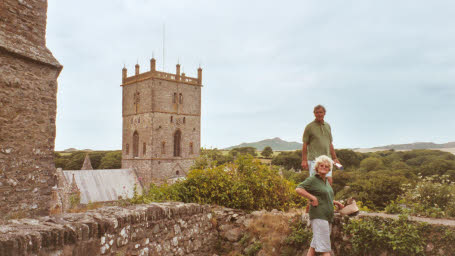
Entrance to the Marina was pretty narrow, and we were lucky to find a berth on a hammerhead, rafted outside a larger vessel that appeared to be laid up. This was to be our home for the next 3 nights: our next guests were not due to arrive till the Monday and Douglas was off to join his family on holiday just up the coast. He did, though, spend the first day with us on an expedition by bus to the lovely city of St.David’s, which was great fun whilst, the next day, Liz and I took a bus to Manorbier and walked back along the stunning coastal path.
Rowland and Janet arrived as the weather started to change. Winds had been from the SW for 2 or 3 days, but we were promised a “window” of North Westerlies for 24 hours, though possibly top end of F5, maybe F6. This was a difficult situation. Janet had no sailing experience, and it promised to be rough, with the South Westerlies having built up a swell over the past few days. We set off in late afternoon for Dale Bay and picked up another mooring. It wasn’t comfortable, but it was safe. It didn’t look as though we were going to be able to get to Lundy (only safe in light winds) or Padstow (on a lee shore), but would have to drive for Land’s End.
The morning wasn’t any better, though there wasn’t any Southing in the wind, which was something. Having phoned the coastguard and listened to the mid-day shipping forecast I decided to go. We prepared the main with 3 reefs and cast off. By dawn we were off Land’s End and the wind was dropping. It had been F6 all the way, it had been rough, and I had a sprained ankle to show for it, which was to handicap me for the rest of the voyage. I hadn’t been conscious of it happening, but it must have occurred when we got hit by a rogue wave about 3 in the morning. I was standing in the heads at the time and, by trying to brace myself against the violent twist the boat was making, I must have wrenched my ankle. As I’d banged my head, and my thumb was bleeding from a scrape on the loo-seat cover I didn’t notice the sprain at the time.
Reed’s is pretty disparaging about Newlyn, but I didn’t feel we were in any state to go on to Falmouth, so headed for the harbour entrance.No response on VHF from the Harbourmaster, though. Imagine our delight when we spied a brand new pontoon with several vacant berths. A week earlier and we’d have had to take pot luck rafting alongside a trawler, or the harbour wall.
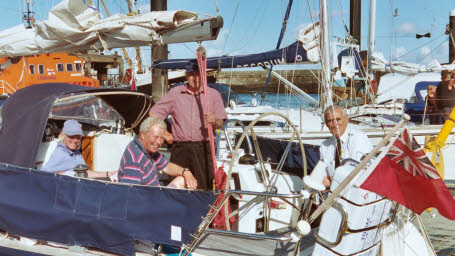
We spent the next 2 days recuperating and arguing with the local fishermen and anyone else who wanted to voice an opinion. We never met the Harbourmaster, or his assistant. It turned out that the pontoon had been funded by DEFRA
purely for the use of the local fishing industry. The problems were: it didn’t look like a fishing dock, it looked like a yachting pontoon – and there were other yachts moored on it, and there were no notices to explain the situation. They wanted us to move, and threatened to cut our lines if we didn’t but, in the end, we settled our differences and staid put until we were ready to leave.
From then on, I didn’t see much inland, as I was pretty well confined to the boat. We had a good passage to Falmouth, with a Northerly F4 and plenty of sunshine and then a day under engine to Plymouth under hot, flat calm conditions. As we enter Sutton Harbour, one of many marinas in Plymouth, we catch sight of Morning Star (RHYC president’s bateau) moored alongside.
We have an excellent dinner at Bistro Bene, right alongside the marina and who, usefully, have their phone number visible through binoculars, and then say good-bye to Rowley & Janet after breakfast the next morning.
Liz sets off on her own, to explore the Hoe, and Smeaton’s Tower, and watch the powerboat racing taking place in the harbour. Mike Graham (the president) drops by for a chat: he’s returning from participating in Cork Week.
Fortunately the marina has excellent laundry facilities and we’re ready for Philip and Judy Worthington who arrive the next day – an easy train journey from Reading.
Next day, Tuesday, is a beautiful day, but with F2 at the most, from the South. After fuelling up, we set off about 09.30, arriving at Dartmouth at 16.30 where, for some inexplicable reason, we’re directed into what must be the best berth in town, on the inside of the Town Quay, right opposite the square. With no need to vacate in the morning, we can relax.
With Portland Bill to round the next day, it’s important to get the tidal timing right, so I judged an 11.00 start would be OK. It turned out to be one of our best day’s sailing with clear blue skies and F4/5 from the Nor nor West. The only puzzle was why we were the only boat heading East, at that time? Reed’s, and the pilot books, do their best to put the fear of God into anyone rounding Portland Bill, without due care and attention, and I spent the day checking and re-checking my calculations. There were droves of boats going the other way.
The wind was a good F5 by the time we got to the Bill at 1830 and we zoomed round, about 50metres off, as advised, with the sea flat and negligible tide. Phew! Unfortunately, our course to Weymouth now involved beating into the same Northerly wind that had helped us previously, and we were another 2 hours doing the last 8 miles, entering the harbour about 20.15 and having to raft up 3 out. Liz did a wonderful job of fetching fish, chips & mushy peas. We’re tired but contented.
A bit more cloud about, on Thursday morning, but still a good F5 from the NW, and we set off for Lymington with one reef in the main. As we round St.Alban’s Head the wind starts to back and we gybe, thereafter enjoying a wonderful beam reach as far Hurst Point,and the North Channel, which I’ve chosen in preference to the Needles Channel (not having had experience of either). Round safely, and into the Lymington River shortly after 6 o’clock. P & J treat us to an excellent dinner in the Yacht Haven restaurant, which is fun and lively.
Not much option about our passage to Hamble Point, the following day, a distance of 12nm, but which takes us a measured 22nm with serious tide against: sometimes as much as 3kts. We plod on under engine & jib alone.
Hamble Point Marina is where Moonshine started her UK existence, so I go and say hello to the chaps at SD Marine, getting my usual frosty greeting. (Ha Ha!) Philip & Judy get a taxi to Southampton station and our son William arrives the following day. Poor chap has already done this leg before, but it’s the only time he could take off.
With tides, and fuel, playing a big part in the next few days passage planning calculations, we made an overnight stop at Gosport (where we re-fuelled) and then set off early on the Wednesday for Eastbourne. By the afternoon the sun was out and we had a F4/5 from the SW: couldn’t be better! By half past three we were entering the lock at Sovereign Harbour and snugly berthed alongside pontoon ‘B’. Dinner in town at an excellent Thai restaurant.
A rude shock the next day. Wind’s on the nose. We spend most of the day motoring, but have an enjoyable day past interesting coastline and dodging the ferries at Dover. It’s hot, and quite late when we get to Ramsgate, which turns out to be full. Eventually find a very pleasant berth rafted one out against an old gaff cutter. Early start planned for the morning.
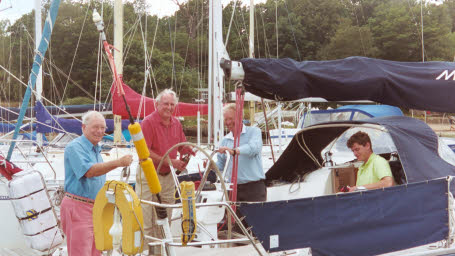
Slip our lines just before 06.00 and hoist our main in the harbour. It’s a good breeze, but pretty well dead astern, and cloudy. I decide to go outside Kentish Knock, for ease of navigation, and this works quite well – particularly after altering course at Longsand Head, as the wind is still from the South. Just enough other boats about to make it interesting, and we catch the favourable tide for a lot of the way, including the last hour or so up-river. About half past one we’re abeam of Landguard. I’ve completed my circuit and logged just over 2000 nautical miles.
At exactly 3 o’clock we’re back in our home berth at Royal Harwich Yacht Club and 5 minutes later the welcoming party arrive! We’ve done it.
 Five years ago I was fortunate to be invited to crew on a friend’s yacht from Peterhead to Oban through the Caledonian Canal. This was a memorable and enjoyable experience which gave me my first taste of sailing in Scotland and which I was determined to build on.
Five years ago I was fortunate to be invited to crew on a friend’s yacht from Peterhead to Oban through the Caledonian Canal. This was a memorable and enjoyable experience which gave me my first taste of sailing in Scotland and which I was determined to build on. After catching up on some sleep we had a little time to explore. I climbed the 199 steps to the church and abbey and admired the view.
After catching up on some sleep we had a little time to explore. I climbed the 199 steps to the church and abbey and admired the view.
 We said good-bye to Tony the following morning and anxiously waited for news of Johnathan, who’d gone incommunicado – only taking relayed text messages via his girl-friend in Wales. I’d originally asked J. to be in Wick by 18th, yet it looked as though 16th and 17th would remain calm but winds due to freshen on the 18th. Ian and I took the bus to John O’Groats to reconnoitre. This proved to be very interesting and somewhat reassuring. We could quite easily see across the Firth and identify where we were due to go by boat, these Southern Orkney Isles being only about 5 miles away at most
We said good-bye to Tony the following morning and anxiously waited for news of Johnathan, who’d gone incommunicado – only taking relayed text messages via his girl-friend in Wales. I’d originally asked J. to be in Wick by 18th, yet it looked as though 16th and 17th would remain calm but winds due to freshen on the 18th. Ian and I took the bus to John O’Groats to reconnoitre. This proved to be very interesting and somewhat reassuring. We could quite easily see across the Firth and identify where we were due to go by boat, these Southern Orkney Isles being only about 5 miles away at most


 A lazy day followed as we pottered down towards the head of the Loch and dropped anchor for lunch under Ben Dampf, enjoying one of the most spectacular views in the Highlands. After a snooze, we motored round to a delightful anchorage opposite the very pretty village of Shieldaig, in the shelter of an island preserved as a heronry, and dinghy ashore in an attempt to catch the shop. Unfortunately too late, but find an excellent outside bar attached to the hotel and have a pretty good meal there, having declined the £41.00 set dinner at the Hotel itself.
A lazy day followed as we pottered down towards the head of the Loch and dropped anchor for lunch under Ben Dampf, enjoying one of the most spectacular views in the Highlands. After a snooze, we motored round to a delightful anchorage opposite the very pretty village of Shieldaig, in the shelter of an island preserved as a heronry, and dinghy ashore in an attempt to catch the shop. Unfortunately too late, but find an excellent outside bar attached to the hotel and have a pretty good meal there, having declined the £41.00 set dinner at the Hotel itself. Three hours later we arrived in Loch Scresort, the main approach for Rum, and dropped anchor in 4.5m, with a fine view of the main attraction: Kinloch Castle, a late Victorian pile built by Sir George Bullough. We dinghied ashore but found we were half an hour late for the daily guided tour, which was a pity. However, by walking round the outside, we were able to see the main features, which were the original furniture and furnishings dating from the late 1890’s when the castle was built.
Three hours later we arrived in Loch Scresort, the main approach for Rum, and dropped anchor in 4.5m, with a fine view of the main attraction: Kinloch Castle, a late Victorian pile built by Sir George Bullough. We dinghied ashore but found we were half an hour late for the daily guided tour, which was a pity. However, by walking round the outside, we were able to see the main features, which were the original furniture and furnishings dating from the late 1890’s when the castle was built. Still cloudy, the following morning, we weigh anchor (from 14 metres) and head West towards Ardmore Point under motor as the wind’s on the nose. By 10 o’clock we can alter course to the South and hoist the sails with a steady breeze from the North West. Past the Treshnish Isles and on to Staffa where we get a great view of the caves from about ¼ mile off. There’s just too much swell to think about putting a party ashore in the dinghy, and not quite enough enthusiasm.
Still cloudy, the following morning, we weigh anchor (from 14 metres) and head West towards Ardmore Point under motor as the wind’s on the nose. By 10 o’clock we can alter course to the South and hoist the sails with a steady breeze from the North West. Past the Treshnish Isles and on to Staffa where we get a great view of the caves from about ¼ mile off. There’s just too much swell to think about putting a party ashore in the dinghy, and not quite enough enthusiasm. Back to the boat and head the 2 miles South to find the entrance to the famous Tinker’s Hole – a renowned favourite amongst yachtsmen in these parts. Sure enough, it’s delightful: a pool enclosed by rocks with not a glimpse of habitation in sight and we anchor in 4m in company of 3 other yachts. The sun comes out and we dine on deck.
Back to the boat and head the 2 miles South to find the entrance to the famous Tinker’s Hole – a renowned favourite amongst yachtsmen in these parts. Sure enough, it’s delightful: a pool enclosed by rocks with not a glimpse of habitation in sight and we anchor in 4m in company of 3 other yachts. The sun comes out and we dine on deck. Heading back to Crinan next morning, I caught sight of the Ajax – this time at anchor (ref. log of Lady Jan Claire, when she was spotted under sail), before we were overwhelmed by the most amazing school of dolphins. For an ½ hour or so they frolicked and gambolled around the boat, perhaps 20 in number and leaping and diving all around us. It was unforgettable.
Heading back to Crinan next morning, I caught sight of the Ajax – this time at anchor (ref. log of Lady Jan Claire, when she was spotted under sail), before we were overwhelmed by the most amazing school of dolphins. For an ½ hour or so they frolicked and gambolled around the boat, perhaps 20 in number and leaping and diving all around us. It was unforgettable. We awake in Cambeltown to rain and overcast skies and not much breeze. What there is is from the NE so we’re able to motor sail till we get abeam the Sanda Isles where the wind freshens nicely and we’re able to beam reach for 2 or 3 hours before it dies completely as we approach Glenarm. Here we find plenty of room, in the cosy harbour, and tie up alongside in a visitor’s berth. After deflating and stowing the dinghy, which we’d towed for 500 miles, we walked into town for supplies. As the evening drew in, a thick fog descended, and we watched in amazement as the local rowing fours practised up and down the harbour, looming out of the gloom with the cox yelling instructions. All modern facilities here, with good showers and free internet access in the HM’s office.
We awake in Cambeltown to rain and overcast skies and not much breeze. What there is is from the NE so we’re able to motor sail till we get abeam the Sanda Isles where the wind freshens nicely and we’re able to beam reach for 2 or 3 hours before it dies completely as we approach Glenarm. Here we find plenty of room, in the cosy harbour, and tie up alongside in a visitor’s berth. After deflating and stowing the dinghy, which we’d towed for 500 miles, we walked into town for supplies. As the evening drew in, a thick fog descended, and we watched in amazement as the local rowing fours practised up and down the harbour, looming out of the gloom with the cox yelling instructions. All modern facilities here, with good showers and free internet access in the HM’s office. course. At the same time, the sea state was lumpier than we’d been used to, so it was quite tough going beating into F4 and later F5. By 4 o’clock we still had over 20miles to go and conditions were worsening so we put the engine on and motor-sailed. At 5 o’clock we put a second reef in the jib and main and battled on. It was 8.15 when we tied up in Howth, only to be told we would have to move so Liz was despatched to warn the cook, while the rest of us tidied up. Scruffy, but elated, and swaying like mad, we found the warmest possible welcome in what turned out to be a very smart dining room. It was Saturday night and Donald’s birthday so we celebrated in style. The surroundings and cuisine were 5 star and, to cap it all, the Chief Steward, on hearing that I was on a circumnavigation, presented me with a very fine volume telling the history of Howth Yacht Club.
course. At the same time, the sea state was lumpier than we’d been used to, so it was quite tough going beating into F4 and later F5. By 4 o’clock we still had over 20miles to go and conditions were worsening so we put the engine on and motor-sailed. At 5 o’clock we put a second reef in the jib and main and battled on. It was 8.15 when we tied up in Howth, only to be told we would have to move so Liz was despatched to warn the cook, while the rest of us tidied up. Scruffy, but elated, and swaying like mad, we found the warmest possible welcome in what turned out to be a very smart dining room. It was Saturday night and Donald’s birthday so we celebrated in style. The surroundings and cuisine were 5 star and, to cap it all, the Chief Steward, on hearing that I was on a circumnavigation, presented me with a very fine volume telling the history of Howth Yacht Club. Entrance to the Marina was pretty narrow, and we were lucky to find a berth on a hammerhead, rafted outside a larger vessel that appeared to be laid up. This was to be our home for the next 3 nights: our next guests were not due to arrive till the Monday and Douglas was off to join his family on holiday just up the coast. He did, though, spend the first day with us on an expedition by bus to the lovely city of St.David’s, which was great fun whilst, the next day, Liz and I took a bus to Manorbier and walked back along the stunning coastal path.
Entrance to the Marina was pretty narrow, and we were lucky to find a berth on a hammerhead, rafted outside a larger vessel that appeared to be laid up. This was to be our home for the next 3 nights: our next guests were not due to arrive till the Monday and Douglas was off to join his family on holiday just up the coast. He did, though, spend the first day with us on an expedition by bus to the lovely city of St.David’s, which was great fun whilst, the next day, Liz and I took a bus to Manorbier and walked back along the stunning coastal path. We spent the next 2 days recuperating and arguing with the local fishermen and anyone else who wanted to voice an opinion. We never met the Harbourmaster, or his assistant. It turned out that the pontoon had been funded by DEFRA purely for the use of the local fishing industry. The problems were: it didn’t look like a fishing dock, it looked like a yachting pontoon – and there were other yachts moored on it, and there were no notices to explain the situation. They wanted us to move, and threatened to cut our lines if we didn’t but, in the end, we settled our differences and staid put until we were ready to leave.
We spent the next 2 days recuperating and arguing with the local fishermen and anyone else who wanted to voice an opinion. We never met the Harbourmaster, or his assistant. It turned out that the pontoon had been funded by DEFRA purely for the use of the local fishing industry. The problems were: it didn’t look like a fishing dock, it looked like a yachting pontoon – and there were other yachts moored on it, and there were no notices to explain the situation. They wanted us to move, and threatened to cut our lines if we didn’t but, in the end, we settled our differences and staid put until we were ready to leave. Slip our lines just before 06.00 and hoist our main in the harbour. It’s a good breeze, but pretty well dead astern, and cloudy. I decide to go outside Kentish Knock, for ease of navigation, and this works quite well – particularly after altering course at Longsand Head, as the wind is still from the South. Just enough other boats about to make it interesting, and we catch the favourable tide for a lot of the way, including the last hour or so up-river. About half past one we’re abeam of Landguard. I’ve completed my circuit and logged just over 2000 nautical miles.
Slip our lines just before 06.00 and hoist our main in the harbour. It’s a good breeze, but pretty well dead astern, and cloudy. I decide to go outside Kentish Knock, for ease of navigation, and this works quite well – particularly after altering course at Longsand Head, as the wind is still from the South. Just enough other boats about to make it interesting, and we catch the favourable tide for a lot of the way, including the last hour or so up-river. About half past one we’re abeam of Landguard. I’ve completed my circuit and logged just over 2000 nautical miles.